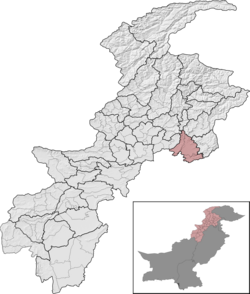Top Qs
Timeline
Chat
Perspective
Haripur District
Districts in Pakistan From Wikipedia, the free encyclopedia
Remove ads
Haripur District (Hindko, Urdu: ضلع ہری پور) is a district in the Hazara Division of Khyber Pakhtunkhwa, Pakistan. Before obtaining the status of a district in 1991, Haripur was a tehsil of Abbottabad District Its headquarters are the city of Haripur. According to 2023 Pakistani census population of Haripur District is 1,173,056 (1.1 million).
Remove ads
History
During British rule what now constitutes Haripur district was an administrative subdivision (tehsil) of Hazara District.[3]
The tehsil was described by the Imperial Gazetteer of India, compiled over a century ago during British rule as follows:
Tahsil of Hazāra District, North-West Frontier, lying between 33° 44′ and 34° 18′ N. and 72° 33′ and 73° 14′ E., with an area of 657 square miles. It is bounded on the north-west by the Indus. The tahsil consists of a sloping plain, from 1,500 to 3,000 feet high, through which the Siran and Harroh flow. Low hills are dotted here and there over the plain. The population in 1901 was 151,638, compared with 142,856 in 1891. It contains the town of HARIPUR (population, 5,578), the head-quarters; and 311 villages. The land revenue and cesses in 1903-4 amounted to Rs. 1,72,000".[4]
On 30 June 1976, the Pakistani government bifurcated Hazara District, Mansehra Tehsil became a district in its own right and the two remaining tehsils Abbottabad and Haripur formed the district of Abbottabad.[5]
In 1991 the tehsil of Haripur was split off from Abbottabad to form Haripur District.[6]
Remove ads
Geography

Geographically, the district borders the Abbottabad District to the northeast, Mansehra District to the northeast, the Punjab to the southeast, the Buner to the northwest, and Swabi to the west. The federal capital of Islamabad is adjacent to the district in the south.
Demographics
Summarize
Perspective
As of the 2023 census, Haripur district has 192,451 households and a population of 1,174,783. The district has a sex ratio of 101.43 males to 100 females and a literacy rate of 74.88%: 84.13% for males and 65.61% for females. 282,230 (24.06% of the surveyed population) are under 10 years of age. 147,765 (12.58%) live in urban areas.[1]
Languages
At the time of the 2023 census, 942,172 of the population spoke Hindko, 172,471 spoke Pashto, 23,423 Urdu, and 11,854 Punjabi and 23,136 others as their first language.[8]
Ethnic groups
Main ethnic groups in Haripur district are:
Religion
Remove ads
Administration
The district of Haripur was a tehsil (sub-division) of the Abbottabad District until 1992. After that, it received the status of an independent district.[14] Currently, Haripur District is divided into three Tehsils:
There were 30 Union Councils in 1962 and in 1979, 25 UC were reconstituted.
Provincial Assembly
Remove ads
Education
Haripur District has two government-funded postgraduate colleges, providing higher-level education, as well as four-degree colleges for women. The Haripur University was established in 2012, which was initially a Haripur campus (established in March 2008) of the Hazara University .The campus was upgraded to a full-fledged University of Haripur (UoH) in 2012 by the Government of Khyber Pakhtunkhwa.[19][20]
In addition, the project of the Pak-Austria Fachhochschule Institute of Applied Sciences and Technology has also been functioning and is providing higher education since 2017 in village Mang at the main Khanpur Road in Haripur.[citation needed]
Remove ads
See also
References
Further reading
Wikiwand - on
Seamless Wikipedia browsing. On steroids.
Remove ads



